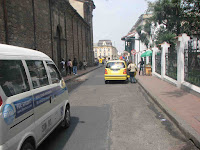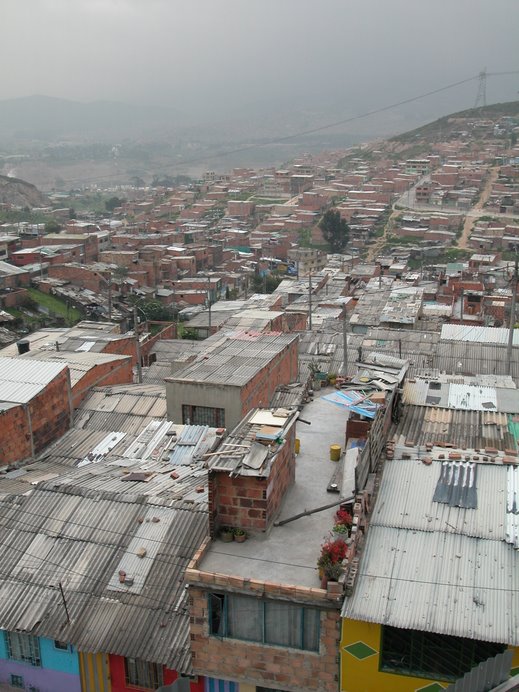 |
| Car-Free Day? But look at how blue the sky is! |
Thursday Feb. 3 was Bogotá's annual
Car-Free Day, renamed recently by the mayor as
Clean Air Day. Both are misnomers, of course, judging by the t
housands of taxis on the streets (aren't they cars?) and the
smog-belching buses.
 |
A group of U. de los Andes students pedaling home. But
how many of them rode the next day? |
Still, the day did make a difference - according to El Tiempo newspaper, airborne
soot declined 16 percent, carbon monoxide 44 percent, sulphur dioxide 49 percent and nitrous dioxide 18 percent. However, ozone concentrations increased by
9 percent. Authorities cited 151 buses for violating pollution laws - which seems like a token number, considering the thousands of 'rolling chimneys' in this city.
El Tiempo reported that the number of cyclists increased 46 percent.
The reason why air pollution declined was made plain by El Tiempo's photos of the same spot on the Autopista Norte at 4:30 p.m. Wednesday and Thursday - on Wednesday the traffic, mostly private cars, was congested and crawled along (while the Transmilenio buses did advance). On Thursday the
buses, no longer blocked by private cars, advanced freely. (El Tiempo reported that public transit moved 15 percent faster.)
But, as
this essay argues, the car-free day seems to have lost its original didactic purpose. Sure, I saw a few signs and posters boasting about the benefits of cleaner air. But, when Car-Free Day was created during the mayoralty of Enrique Peñalosa, it was supposed
to encourage car owners to think of others ways of getting around. Of course, that's a lot to ask of a one-day event, especially in a city in which every car is banned from circulating two days each week anyway, based on its license plate number.
This commentary describes the day as pretty futile, while
this one describes Bogotá's traffic troubles without suggesting a solution.
Rather, based on what I've heard from callers to radio stations, most Bogotá car-owners think of the car-free day as a nuisance to be suffered through. For many, probably, it's an excuse to take a day off of work, which I guess that's their problem. But if the city really wants this event to make a difference, it should create a real educational campaign, together with serious economic incentives and disincentives, to get people out of their cars. Of course, the very best solution would be to
make every day car-free day.
 |
| On Friday, smog's back again. |
By the next day's observations, the Car-Free Day didn't change many habits. Friday was yet another smoggy day. And, appropriately,
Portfolio reported record numbers of new car sales. And
this El Tiempo editorial argues that the cars will keep coming, so the city better prepare for them. But why is that, any more than if
bogotanos suddenly began buying thousands of elephants or jackhammers? City government would surely impose measures to restrict elephant and jackhammer use - so why does the city feel obliged to assume the costs of car ownership? This is particularly true in Bogotá, where
private vehicles still account for only about 23 percent of trips.
Despite everything, Car-Free Day is important if only because it generates discussion about transit solutions here, and for at least one day a congested, car-crammed reality isn't taken for granted. Unfortunately, we're still waiting for real solutions (since Pico y Placa has so obviously failed): this article advocates measures including more bikes and carpools, but doesn't touch on the fundamental problem: too many damn cars!
Meanwhile, feeling quite quixotic, several of us from
Bogota Bike Tours protested against air pollution along smoggy Seventh Ave.
On Car-Free Day, the city government announced several measures to combat air pollution, including
banning those pollution-belching two-cycle motorcycles, requiring catalitic converters and filters on some vehicles and placing pollution limits on brick factories. But, judging by the utter lack of enforcement of existing laws, one wonders whether these will mean anything.
Anti-pollution laws, sadly, appear to be thoroughly ignored in this city - both by polluters and by those charged with enforcing the law. So, we're
campaigning to change that!
 |
| No more air pollution! |
By Mike Ceaser, of
Bogotá Bike Tours



































